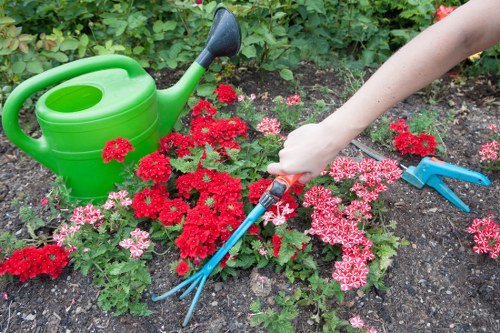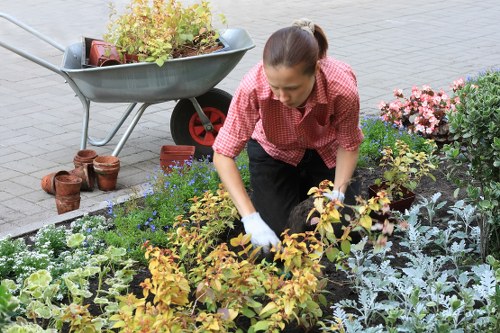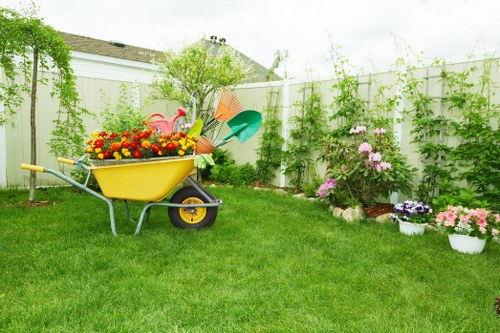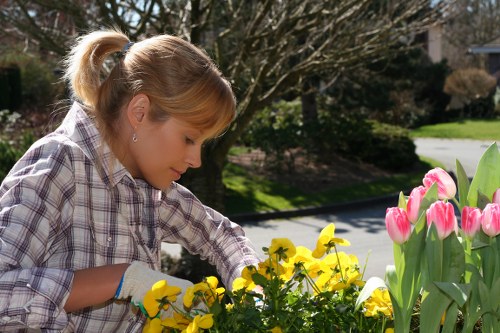Garden Maintenance in Swiss Cottage

Maintaining a beautiful garden in Swiss Cottage requires a blend of careful planning, regular upkeep, and a keen eye for detail. Whether you’re a seasoned gardener or just starting out, understanding the unique needs of your garden can make all the difference in achieving a lush and vibrant outdoor space.
Swiss Cottage, with its picturesque landscapes and temperate climate, provides an ideal environment for a variety of plants. However, the specific conditions here mean that certain maintenance practices are essential to ensure your garden thrives throughout the year.
In this article, we will explore comprehensive garden maintenance strategies tailored specifically for Swiss Cottage residents. From seasonal planting schedules to pest control and soil management, our guide aims to help you create and sustain a garden that is both beautiful and resilient.

The Importance of Regular Garden Maintenance
Regular garden maintenance is crucial for several reasons. It not only enhances the aesthetic appeal of your property but also promotes the health and growth of your plants. Consistent care helps prevent issues such as pests, diseases, and weed overgrowth, which can quickly compromise the vitality of your garden.
Moreover, a well-maintained garden contributes to the overall ecosystem, attracting beneficial insects and providing a habitat for local wildlife. By dedicating time and resources to garden upkeep, you’re investing in a sustainable and thriving outdoor space.
In Swiss Cottage, where gardens often serve as extensions of living spaces, maintaining your garden can also increase the value of your property and provide a serene retreat for relaxation and enjoyment.

Seasonal Garden Maintenance Tips
Understanding the seasonal changes in Swiss Cottage is key to effective garden maintenance. Each season brings its own set of challenges and opportunities for gardeners to nurture their plants and prepare for the weather ahead.
Spring
Spring is a time of renewal, making it the perfect season to start fresh with your garden. Begin by clearing away any debris left from the winter months. Prune dead branches from trees and shrubs, and prepare your soil by adding compost or organic matter to enrich it.
Planting new flowers, vegetables, and herbs should also take place in the spring. Focus on species that thrive in Swiss Cottage’s climate, ensuring they have the best start before the heat of summer sets in.
Summer
During the summer months, garden maintenance shifts towards managing growth and ensuring plants stay healthy under the warmer temperatures. Regular watering is essential, especially during dry spells. Implementing an efficient irrigation system can help maintain consistent moisture levels without wasting water.
Weeding becomes a continuous task to prevent unwanted plants from competing with your garden’s flora. Additionally, monitor for pests and diseases, taking prompt action to address any issues that arise.

Autumn
Autumn is a critical period for preparing your garden for the colder months. Begin by harvesting any remaining produce and removing spent plants to make way for new growth in the spring. Raking fallen leaves not only keeps your garden tidy but also provides valuable compost material when processed and returned to the soil.
Protect sensitive plants by mulching around their bases, which helps insulate roots and retain soil moisture. Prune back overgrown shrubs and trees to encourage healthy growth and prevent damage from heavy snowfall.
Winter
Winter maintenance focuses on protecting your garden during the dormant season. Cover delicate plants with frost cloths to shield them from frostbite, and ensure that any perennial beds are properly mulched to prevent soil erosion and temperature fluctuations.
Take this time to plan for the upcoming year by researching new plant varieties and designing your garden layout. Indoor gardening projects, such as seed starting, can also keep your gardening skills sharp during the colder months.

Essential Tools for Garden Maintenance
Having the right tools is fundamental to effective garden maintenance. Investing in quality equipment not only makes tasks easier but also ensures that you can maintain your garden efficiently and safely.
Basic Gardening Tools
- Pruners and Shears: Essential for trimming and shaping plants, as well as removing dead or diseased foliage.
- Spade and Shovel: Useful for digging, planting, and moving soil or compost.
- Rake: Necessary for clearing leaves, leveling soil, and preparing garden beds.
Advanced Gardening Equipment
- Hose and Irrigation Systems: Ensure your plants receive adequate water, especially during dry periods.
- Wheelbarrow: Facilitates the transport of heavy materials like soil, compost, and mulch.
- Garden Kneeler: Provides comfort and support while working close to the ground.
Tool Maintenance
Regular maintenance of your gardening tools extends their lifespan and ensures they perform optimally. Clean tools after each use to prevent rust and corrosion, and sharpen blades periodically to maintain their effectiveness.
Proper storage is also important; keep tools in a dry, organized space to avoid damage and make them easily accessible for your next gardening session.

Pest and Disease Management
Effective pest and disease management is vital for maintaining a healthy garden. In Swiss Cottage, common pests include aphids, slugs, and snails, which can cause significant damage if left unchecked.
Organic Pest Control Methods
Opting for organic pest control methods helps protect beneficial insects and maintains the ecological balance of your garden. Introducing natural predators, such as ladybugs and predatory beetles, can keep pest populations under control.
Using barriers like copper tape around plant pots can deter slugs and snails, while neem oil sprays can effectively manage a range of insect pests without harming the environment.
Preventative Measures
Preventing pests and diseases starts with maintaining plant health. Avoid over-fertilizing, as excessive nutrients can attract pests. Ensure proper spacing between plants to promote air circulation, reducing the likelihood of fungal diseases.
Regularly inspect your plants for early signs of infestation or infection. Promptly removing affected areas can prevent the spread and minimize damage.

Soil Management and Fertilization
Healthy soil is the foundation of a thriving garden. Proper soil management involves understanding the soil composition, pH levels, and nutrient content to provide the best possible environment for plant growth.
Soil Testing
Conducting a soil test helps determine the nutrient levels and pH balance of your garden soil. This information is crucial for selecting appropriate fertilizers and amendments to address any deficiencies or imbalances.
Swiss Cottage soils are typically rich in organic matter, but testing ensures you tailor your soil management practices to your garden’s specific needs.
Amending the Soil
Adding organic matter, such as compost or well-rotted manure, improves soil structure, drainage, and fertility. Incorporate these amendments into the soil during planting or as a top dressing around established plants.
For sandy or clay-heavy soils, adjusting the composition with organic matter can enhance water retention and root penetration, promoting healthier plant growth.
Fertilization Techniques
Fertilizing your garden provides essential nutrients that support plant development and productivity. Choose fertilizers based on the specific requirements of your plants and the results of your soil test.
Apply fertilizers evenly and avoid over-fertilizing, which can lead to nutrient runoff and environmental issues. Organic fertilizers, such as fish emulsion or bone meal, offer a sustainable alternative to synthetic options.

Pruning and Trimming
Regular pruning and trimming are essential for maintaining the shape, size, and health of your plants. Proper pruning stimulates new growth, removes dead or diseased branches, and enhances the overall appearance of your garden.
Pruning Techniques
Use sharp, clean tools to make precise cuts, minimizing damage to the plant. Prune at the right time of year for each plant species to promote optimal growth and flowering.
For shrubs and hedges, trimming back by one-third can maintain their shape without stressing the plants. When pruning trees, focus on removing crossing branches and promoting a strong central structure.
Deadheading Flowers
Deadheading, or removing spent flowers, encourages continuous blooming and prevents plants from diverting energy into seed production. It also improves the overall appearance of your flower beds.
Regular deadheading is particularly important for annuals and perennials, ensuring your garden remains vibrant and colorful throughout the growing season.

Mulching for Garden Health
Mulching is a fundamental aspect of garden maintenance, offering numerous benefits that contribute to plant health and soil quality. Applying a layer of mulch around your plants helps retain soil moisture, suppress weeds, and regulate soil temperature.
Types of Mulch
- Organic Mulch: Includes materials like bark, straw, leaves, and compost. Organic mulch enriches the soil as it decomposes, adding nutrients and improving soil structure.
- Inorganic Mulch: Consists of materials such as gravel, rubber, or landscape fabric. Inorganic mulch is durable and effective for long-term weed suppression but does not contribute to soil fertility.
Application Tips
Apply mulch in a 2-3 inch layer around your plants, avoiding direct contact with stems or trunks to prevent rot and pests. Replenish mulch annually to maintain its effectiveness and aesthetic appeal.
Choosing the right type of mulch depends on your garden’s needs and the specific requirements of your plants. Combining different mulch types can also provide a balanced approach to garden maintenance.
Benefits of Mulching
Beyond moisture retention and weed suppression, mulching helps prevent soil erosion and reduces temperature fluctuations, creating a stable environment for root development. Additionally, it adds a polished look to your garden beds, enhancing the overall visual appeal.
In Swiss Cottage, where seasonal changes are pronounced, mulching is especially beneficial in preparing your garden for both the growing and dormant periods.

Watering Strategies for Optimal Growth
Effective watering is a cornerstone of successful garden maintenance. Proper irrigation ensures that plants receive the right amount of moisture, promoting healthy growth and preventing stress or damage from over or under-watering.
Determining Water Needs
Different plants have varying water requirements based on their species, growth stage, and environmental conditions. Assessing the specific needs of your garden’s flora is essential for implementing an effective watering strategy.
Soil type also plays a significant role; sandy soils drain quickly and may require more frequent watering, while clay soils retain moisture longer, reducing the need for constant irrigation.
Efficient Watering Techniques
Adopting efficient watering methods can conserve water and ensure even distribution. Drip irrigation systems are highly effective, delivering water directly to the plant roots and minimizing evaporation.
Watering in the early morning or late evening reduces water loss due to evaporation and allows plants to absorb moisture more efficiently. Avoid overhead watering, which can lead to fungal diseases and water waste.
Rainwater Harvesting
Implementing rainwater harvesting systems is an eco-friendly approach to garden watering. Collecting and storing rainwater for later use reduces reliance on municipal water supplies and provides a natural source of moisture for your plants.
Rain barrels or more sophisticated rainwater collection systems can be integrated into your garden maintenance plan, promoting sustainability and cost savings over time.
Lawn Care and Maintenance
A well-maintained lawn serves as the foundation of your garden, providing a green and inviting space for various activities. Proper lawn care involves regular mowing, fertilizing, aerating, and addressing common lawn issues.
Mowing Techniques
Mowing your lawn to the appropriate height encourages healthy grass growth and prevents weeds from taking hold. Generally, keeping your grass at a height of 2.5 to 3 inches is ideal for most grass types.
Ensure that mower blades are sharp to make clean cuts, reducing stress on the grass and minimizing the risk of disease. Varying your mowing pattern each week can prevent soil compaction and promote even growth.
Fertilization and Aeration
Fertilizing your lawn provides essential nutrients that support dense, green growth. Choose a fertilizer formulated for your specific grass type and apply it according to the recommended schedule.
Aerating your lawn helps alleviate soil compaction, allowing air, water, and nutrients to penetrate deeper into the soil. Aeration should be performed at least once a year, preferably during the growing season for your grass type.
Dealing with Lawn Pests and Diseases
Common lawn pests, such as grubs and chinch bugs, can cause significant damage if not managed effectively. Regularly inspect your lawn for signs of infestation and implement appropriate control measures, such as applying beneficial nematodes or using targeted pesticides when necessary.
Preventing lawn diseases involves maintaining proper mowing practices, adequate watering, and ensuring good air circulation. Avoid over-fertilizing, as excessive nutrients can promote the growth of harmful fungi.
Incorporating Sustainable Practices
Sustainability in garden maintenance not only benefits the environment but also enhances the resilience and health of your garden. Implementing eco-friendly practices ensures that your garden remains a thriving ecosystem for years to come.
Composting
Composting is a natural way to recycle organic waste, turning kitchen scraps and garden debris into rich, fertile soil for your garden. By composting, you reduce landfill waste and provide your plants with essential nutrients.
Create a compost bin in your garden, layering green materials like vegetable scraps with brown materials such as leaves and straw. Regularly turning the compost ensures proper decomposition and reduces odors.
Water Conservation
Conserving water is vital, especially in regions prone to drought. Implementing water-saving techniques like mulching, using drought-resistant plants, and installing rain barrels can significantly reduce your garden’s water consumption.
Additionally, grouping plants with similar water needs together, known as hydrozoning, optimizes irrigation efficiency and minimizes water waste.
Beneficial Wildlife
Encouraging beneficial wildlife, such as bees, butterflies, and birds, supports pollination and natural pest control. Planting native species and providing habitats like birdhouses and insect hotels creates a welcoming environment for these essential creatures.
By fostering biodiversity in your garden, you enhance its ecological balance and contribute to the overall health of the local environment.
Choosing the Right Plants for Swiss Cottage Gardens
Selecting plants that are well-suited to the Swiss Cottage climate and soil conditions is fundamental for a successful garden. Opt for species that thrive in the temperate weather, ensuring minimal stress and abundant growth.
Perennials and Annuals
Incorporate a mix of perennials and annuals to create a dynamic and colorful garden throughout the year. Perennials provide long-lasting structure and return each season, while annuals offer vibrant blooms and versatility.
- Perennials: Lavender, hostas, and roses are excellent choices for adding longevity and fragrance to your garden.
- Annuals: Marigolds, petunias, and impatiens can introduce seasonal color and variety.
Shade and Sun Plants
Assess the sunlight patterns in your garden to determine which areas receive full sun, partial shade, or full shade. Selecting plants that match these conditions ensures optimal growth and health.
For sunny spots, consider sun-loving plants like geraniums and sunflowers. In shaded areas, ferns and astilbes provide lush greenery and delicate flowers without requiring direct sunlight.
Native Plants
Incorporating native plants into your garden supports local biodiversity and requires less maintenance, as they are adapted to the regional climate and soil conditions. Native species tend to be more resilient against pests and diseases common in Swiss Cottage.
Examples of native plants include English bluebells, foxgloves, and primroses, which add natural beauty and environmental benefits to your garden.
Lighting and Garden Features
Enhancing your garden with proper lighting and features like paths, benches, and water elements can create a functional and aesthetically pleasing outdoor space. Thoughtful design elements contribute to the overall ambiance and usability of your garden.
Garden Lighting
Installing garden lighting extends the usability of your garden into the evening hours and highlights key features such as pathways, plants, and architectural elements. Solar-powered lights are an eco-friendly option that reduces energy consumption.
Options include string lights for a cozy atmosphere, spotlights to accentuate specific areas, and lanterns for a classic touch. Ensure that lighting is strategically placed to avoid glare and maintain safety.
Pathways and Walkways
Pathways guide visitors through your garden, making it easier to navigate and appreciate different sections. Choose materials that complement your garden’s style, such as gravel, brick, or natural stone.
Designing curved paths can add a sense of mystery and exploration, while straight walkways provide a more structured and formal appearance.
Water Features
Incorporating water features like fountains, ponds, or waterfalls adds a soothing element to your garden. The sound of flowing water can create a tranquil environment, attracting birds and other wildlife.
Consider the maintenance requirements of each water feature, opting for low-maintenance options if you prefer minimal upkeep. Regular cleaning and proper filtration ensure that water features remain clear and healthy.
Professional Garden Maintenance Services
While DIY garden maintenance can be fulfilling, hiring professional garden maintenance services in Swiss Cottage offers expertise and efficiency that can elevate your garden’s health and appearance. Professionals bring knowledge of local conditions and access to specialized tools and techniques.
Benefits of Hiring Professionals
- Expertise: Professionals understand the specific requirements of different plants and can tailor maintenance practices to suit your garden’s unique needs.
- Time-Saving: Outsourcing garden maintenance frees up your schedule, allowing you to enjoy your garden without the stress of upkeep.
- Comprehensive Services: From pruning and fertilizing to pest control and landscape design, professional services offer a wide range of solutions for a thriving garden.
Choosing the Right Service
Selecting a reputable garden maintenance service involves researching their experience, services offered, and client reviews. Look for companies that prioritize sustainability and eco-friendly practices, aligning with your garden’s values.
Ensure that the service you choose is licensed and insured, providing peace of mind and guaranteeing quality work.
Customized Maintenance Plans
Many professional services offer customized maintenance plans tailored to your garden’s specific needs and your personal preferences. Whether you require regular upkeep or seasonal care, a personalized plan ensures that your garden receives the attention it deserves.
Discuss your garden goals with the service provider to create a maintenance schedule that supports the health and beauty of your outdoor space throughout the year.
Conclusion
Maintaining a garden in Swiss Cottage is a rewarding endeavor that enhances your living space and contributes to environmental well-being. By implementing regular maintenance practices, understanding seasonal needs, and incorporating sustainable techniques, you can cultivate a garden that is both beautiful and resilient.
Whether you choose to manage your garden personally or enlist the help of professional services, the key to success lies in dedication, knowledge, and a passion for nurturing nature. Embrace the joy of garden maintenance and transform your Swiss Cottage garden into a flourishing sanctuary.
Call to Action
Ready to elevate your garden maintenance routine? Contact us today to learn more about our professional garden services in Swiss Cottage and book your service now.

